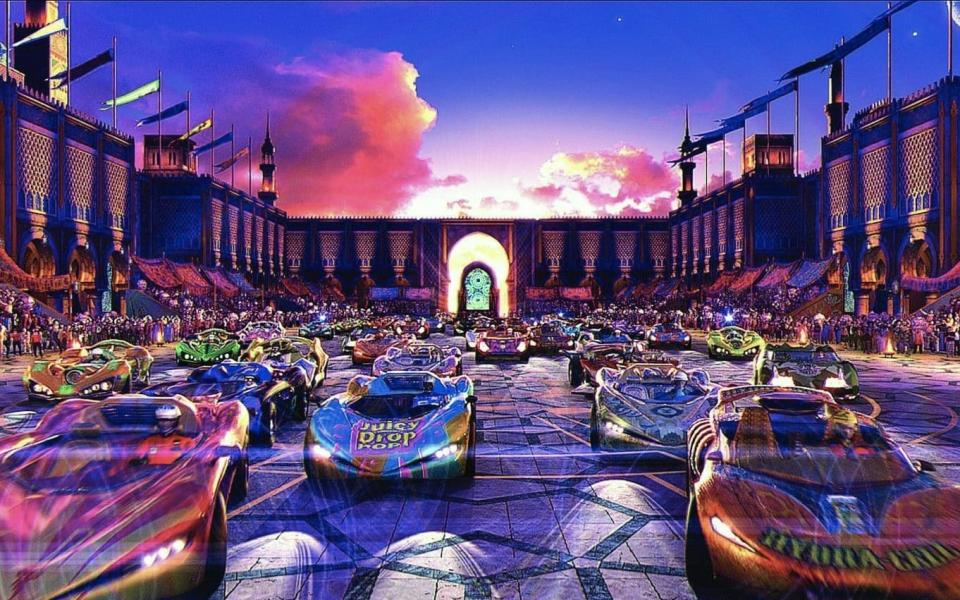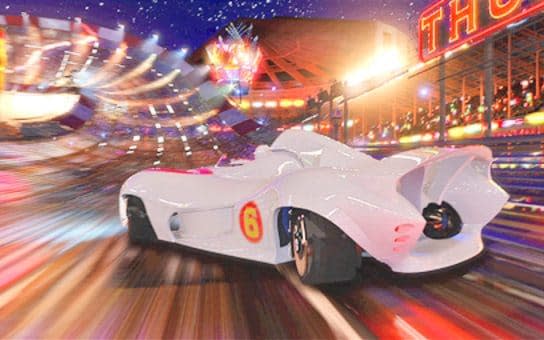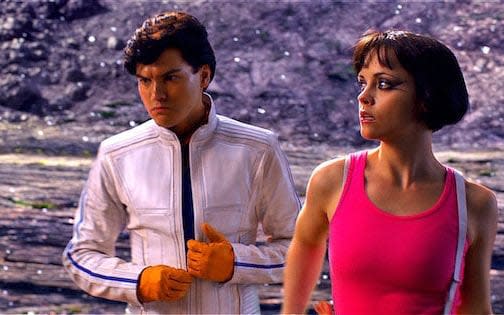Speed Racer: the ‘dangerous’ film that became a Technicolour nightmare

The Wachowskis’ original Matrix trilogy was black and white and green all over. So when it was time for the dystopian siblings to move on from Neo and Trinity, and red pills and blue pills, their first step was to bring in the decorators and swap out the Matrix’s distinctive blend of noirish cool and muggy emerald colours.
The result was 2008’s Speed Racer, a brain-bursting caper so infused with brightness that sitting through all 130 minutes was akin to having a party-pack of Skittles injected into your eyeballs. It shot straight off the track, too, creating a smoking wreckage from which the Wachowskis have arguably yet to recover.
As is the way with extravagantly awful films, Speed Racer has since built a modest cult following. There have even been claims, in the more excitable corners of YouTube, that it helped advance the language of cinema. But the real lesson of Speed Racer was that, if the Wachowskis were good at some things (i.e. making Matrix movies), they were less accomplished at others.
Proof of their feet of clay was smeared all over this $120 million adaptation of an obscure-ish manga featuring such odds ’n’ sods stars as Christina Ricci, Emile Hirsch, John Goodman, Susan Sarandon and a chimpanzee named Kenny. Released in May 2008, the same summer as Marvel’s Iron Man and Christopher Nolan’s The Dark Knight, it stalled on the starter grid, earning just $90 million despite a huge (and increasingly desperate) marking campaign.
And it permanently tarnished the Wachowskis in Hollywood. Their next feature, a 2012 retelling of David Mitchell’s Cloud Atlas, was financed largely in Europe.
Nobody has taken Speed Racer and its failure more to heart than the Wachowskis themselves. This may explain why, this week, Lana Wachowski returns to the duo’s original goldmine with a new Matrix sequel, The Matrix Resurrections. With critics split over the film – The Telegraph laments its lack of momentum, while Vanity Fair hailed its “triumphant defiance” – it remains to be seen where it ultimately ranks in the Matrix hierarchy. One thing is certain: it will be remembered far longer long than Speed Racer.
“We knew the movie was dangerous,” Lana would tell an interviewer years later. “We’re very visual-thinking artists. We’re often drawn to ideas that stimulate our imagination visually. Unfortunately we work in a medium that is one of the most rigid aesthetically.”
With Speed Racer, Lana, who transitioned from Larry around 2010, and Lily, who transitioned from Andy circa 2016, were attempting to re-write the way in which cinema communicated with the audience. However this ambition was not on the “to do” list of Warner Brothers when it approached the Wachowskis to adapt a comic book and TV series much beloved among Baby Boomers. The studio’s more prosaic goal was to conjure up a new franchise.
Speed Racer tells the story of a heroic young driver – named, with what-it-says-on-the-tin straightforwardness, “Speed Racer” – who is determined to carry on the legacy of an older brother who seemingly died on the race track. He is supported by girlfriend Trixie (Christina Ricci, whose fringe may be the single best reason for watching), as well as “Pops” (Goodman) and “Mom” (Sarandon).
There is naturally a villain, in venal businessman EP Arnold Royalton. He is portrayed, slightly incongruously, by Roger Allam – aka Peter Mannion MP in The Thick of It and DI Fred Thursday from ITV’s Endeavour.
With a starting premise like that, Speed Racer could, in theory, have roared into cinemas as a flashy road movie. The kind that might star Vin Diesel or Dwayne Johnson. Rest assured nothing could be further from the case. This was more Weird and Wonky than Fast and Furious.

Speed Racer unfolds in a day-glo Neverland, informed by Japanese cartoons, Nintendo video games and, it is tempting to conclude, Teletubbies boxsets. And though the source material may have been a Beatles-era manga, Speed Racers’ ambitions went far beyond that. The co-directors cited as inspiration the Cubist art of Pablo Picasso and James Joyce’s Ulysses. These are not typical references points for summer blockbusters. Therein lay the problem.
“We’ve always thought it was interesting that no one has done much with the cinematic language of editing,” said Lana. “Editing is a very straightforward grammar: it begins with a capital letter and ends with a period. We thought, ‘Well, because of computers, we have the ability to transcend this older language.’ To try something post-modern… the way writers like Joyce have tried to extend the grammar of literature.”
This was a clever way of saying the Wachowskis wanted to mess with the audiences’ heads slightly (or not so slightly). One way of doing this was to shoot the movie so that the entire frame was in focus, just as it is in cartoons. The background was as prominent as the foreground – a visual trick that sent your brain reeling. Where were you supposed to look? Speed Racer declined to offer any clues.

“Imagine the look of 2D animated cartoons with the entire frame being in-focus and transpose that into live action film,” wrote Alex Billington on website First Showing “Doesn’t make sense, does it? I'm incredibly anxious to see the first look of this.”
The Wachowskis also tried to re-write the rules of cinematic narrative. Speed Racer’s opening 17 minutes flip back and forwards between Speed’s childhood and a race in the present day. As his iconic “Mach Five” racer blazes along the track, dialogue is delivered by characters whose giant heads rotate across the frame. All brought to you in colours that glow like radioactive sugar-cane.
“We thought, wow we could do the first Cubist film – based on the back of someone’s head and the front of their face on screen at the same time,” said Lana, comparing the approach to that of Picasso when painting his 1937 masterpiece Guernica.

Yet the visual complexity was offset by a script seemingly written with attention-deficient six-year-olds in mind. “You think you can drive a car and change the world? It doesn’t work like that!” Pops tells Speed early on. “Maybe not, but it’s the only thing I know how to do and I gotta do something,” replies Speed. It all made Teen Titans Go! sound like Thomas Pynchon by comparison.
Astonishingly, it turned out that the public wasn’t particularly keen on family blockbusters inspired by Pablo Picasso’s mid-century adventures in Cubism or containing dialogue aimed at young children. Not when the alternatives that summer included Iron Man and The Dark Knight.
These films were, in their ways, as groundbreaking as Speed Racer. Iron Man built a superhero movie around the charisma of Robert Downey Jr, a middle-aged character actor whose public image was deemed tarnished beyond repair after a string of substance abuse scandals. And the Dark Knight was a popcorn flick that gazed into the face of madness courtesy of Heath Ledger’s Oscar-wining portrayal of the Joker.
Speed Racer, by contrast, was simultaneously confusing and underwhelming. And with editing that reinvented the language of cinema only in so far as it made the story difficult to follow. The unrelenting colour scheme was only revolutionary to the extent that it risked triggering migraines among the unwary. Even the stars seemed slightly baffled that such a thing could exist, as Emile Hirsch admitted – at the premiere, no less.
“It was like a mind trip every day,” he said. “Like being on a mental ward or something. The most crazy person wins. The most crazy person gives the most realistic work. You’re literally looking at a green wall – talking at it, pretending it’s there.”
He paused as if experiencing a flashback. And then he added: “Very strange.”

